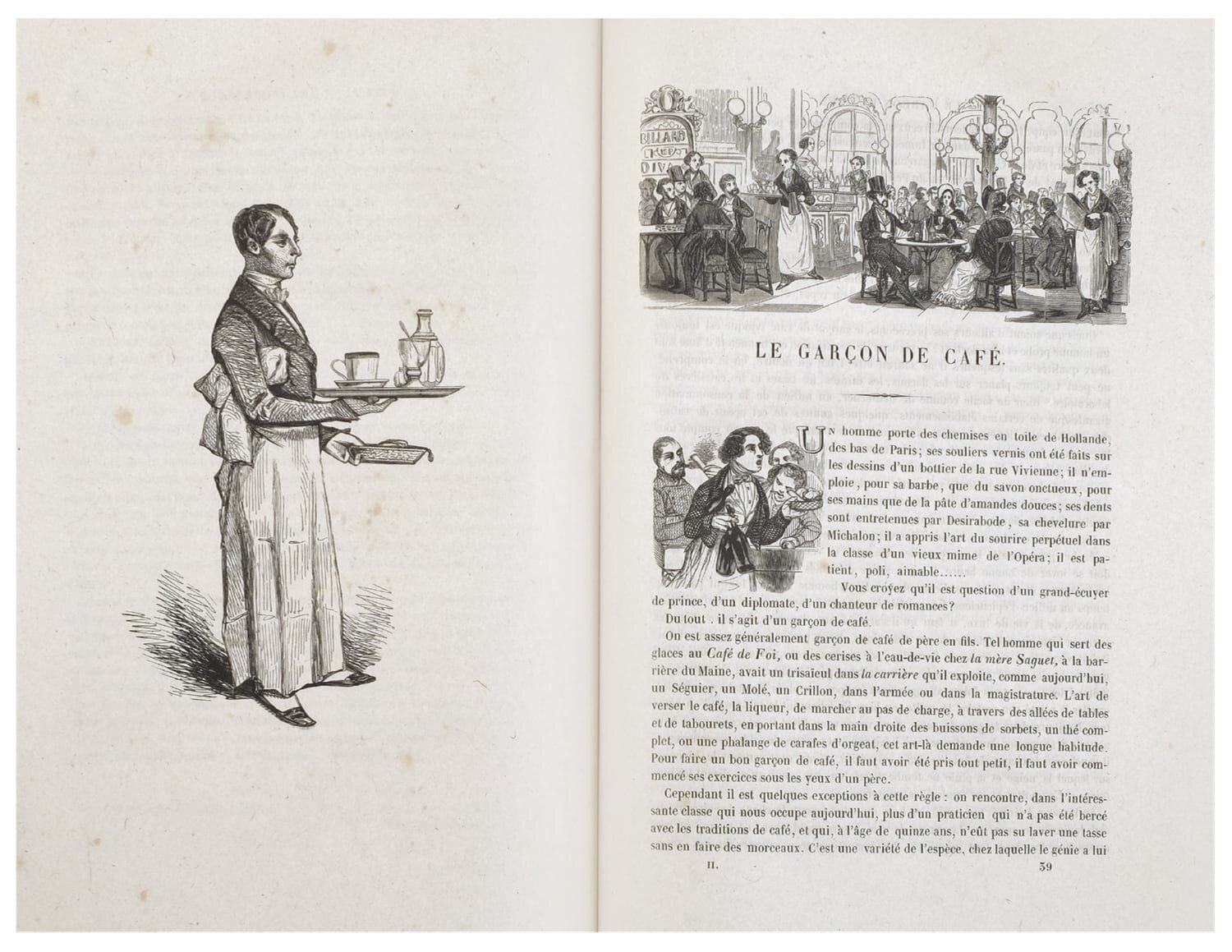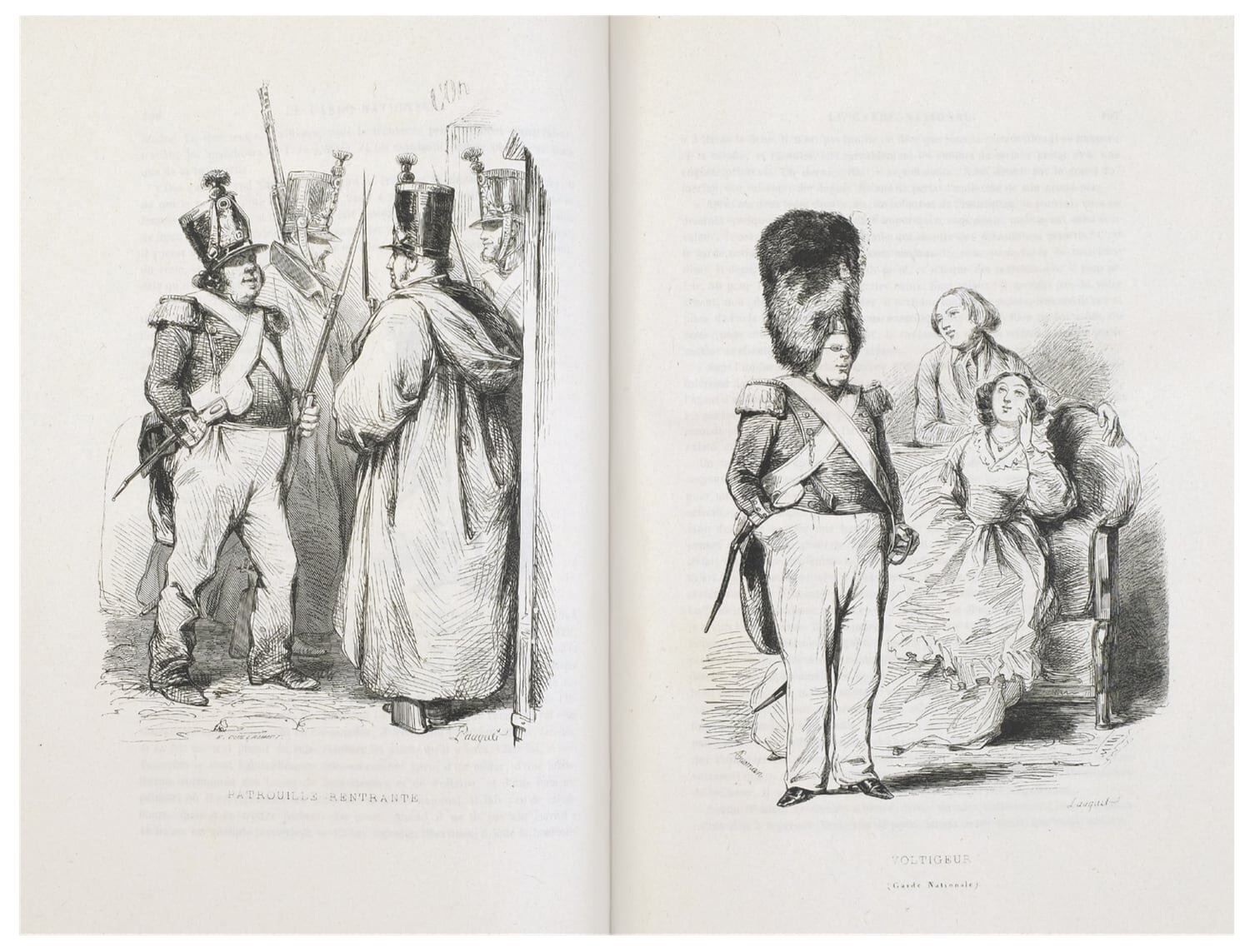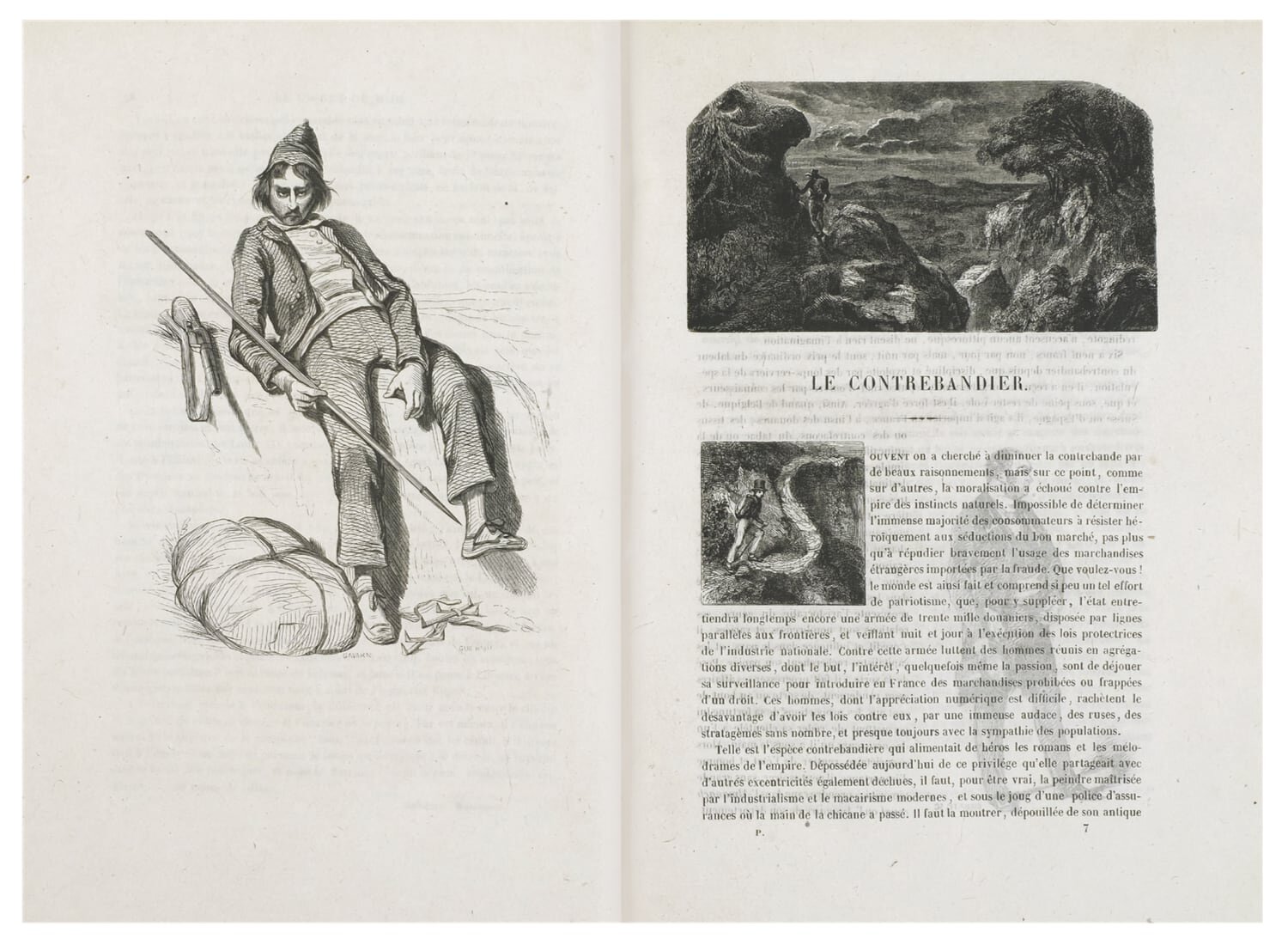XI. The French in Their Own Image
XI. The French in Their Own Image
Les Français peints par eux-mêmes
By the mid-19th century, constitutional monarchy had been consolidated. At the same time, book production also entered a new phase of collecting and stock-taking, inspired by the encyclopaedias of the Enlightenment era. Still considered to be the “social encyclopaedia of the 19th century” [Renonciat], Les Français peints par eux-mêmes (The French in their own image), was the most ambitious undertaking by the publisher Léon Curmer, published between 1840-42 in 422 fascicles or eight volumes. The entirety of French society at the time of the July Monarchy is classified by profession and occupation, and presented in text and image. For the texts, Curmer hired the most important authors of the time, such as Honoré de Balzac, Théophile Gautier, Jules Janin, Charles Nodier, as well as Gérard de Nerval and Alexandre Dumas.
Out of all the illustrators involved, Paul Gavarni was the style-defining and quantitatively most important contributor, with almost 200 vignettes, followed by Hippolyte Émile Pauquet. They are joined by other famous artists, such as Grandville, Tony Johannot and Honoré Daumier (the latter was responsible for the 16 of the strongest and most creative illustrations in the entire work). Henry Monnier and Charles Joseph Traviès were hired as "specialists" in the depiction of the lower classes, Eugène Lami portrayed the military, while other artists were responsible for the colonies. Also involved were Hippolyte Bellangé, Nicolas-Toussaint Charlet, Charles François Daubigny, Adrien Dauzats, Henri Émy, Charles Émile Jacque, Alcide Joseph Lorentz, Ernest Meissonier and Octave Penguilly; truly a who's who of the French art of drawing at the time.
The contemporary copy on China paper [no. 210], bound in simple half morocco is of the greatest rarity: Léopold Carteret knew of only three or four of such complete copies. Even more spectacular is the copy - the only known - in which the almost 2000 illustrations appear in vivid original colouring. Apparently, this was Curmers own sample copy [no. 211].
The copy on China paper, which originally belonged to Gavarni himself, represents a bibliophilic ideal: here the vast majority of the over 400 avant la lettre printed plates received lengthy captions by the artist himself. On top of that, the collector Paul Sébastien Gallimard extended the copy even further by adding a wealth of exceptional material: a whole extra volume containing 56 mostly colored originals by 21 different artists, including Daumier's famous depiction of the Défenseur officieux en justice de paix, two watercolors by Gavarni, two pencil drawings each by Tony Johannot and Charlet, three pen drawings by Grandville, four by Henri Monnier, as well as the original envelope design by Adrien Féart, and more. A near-complete second set of coloured plates on vellum paper was bound into three volumes, along with over 500 proofs of plates and wood engravings on China paper, and all original wrappers in two further volumes [no. 212]. Gallimard also added the Le Prisme (again including proofs) and the two volumes of the parallel work Les Anglais peints par eux-mêmes. When Carteret saw this ensemble, he was lost for words: “this copy is a miracle”.
Linking the original drawings to the prints in various states stands the collection of 18 printing blocks in glass frames. Among them is the allegorical depiction of the publisher as Mephisto [no. 216], and the two-part model for the wrappers of the fascicles, as well as the frontispiece to volume I [no. 213], which Grandville parodied in the poster for his Scènes de la vie.




![Extremely rare complete copy on China paper [no. 210], bound in simple brown half-morocco, with black half-morocco covers](https://images.squarespace-cdn.com/content/v1/5b02a5098ab7225ab8d3a10c/1594139871246-KK0NX8AU9I8L64P5F82I/210b.jpg)
![Extremely rare complete copy on China paper [no. 210], bound in simple brown half-morocco, with black half-morocco covers](https://images.squarespace-cdn.com/content/v1/5b02a5098ab7225ab8d3a10c/1594139870674-R1R1N77EC4A924POUVSU/210c.jpg)
![This is the only copy known with original colouring. It also includes all original wrappers [no. 211]](https://images.squarespace-cdn.com/content/v1/5b02a5098ab7225ab8d3a10c/1594141217885-JKCH1HC7ADTFUGPOSTL8/211f.jpg)
![This is the only copy known with original colouring. It also includes all original wrappers [no. 211]](https://images.squarespace-cdn.com/content/v1/5b02a5098ab7225ab8d3a10c/1594141200862-8S2BAPYAC9Q7Z4MALT6N/211e.jpg)
![This is the only copy known with original colouring. It also includes all original wrappers [no. 211]](https://images.squarespace-cdn.com/content/v1/5b02a5098ab7225ab8d3a10c/1594141236642-ZW74M958XG7L6A0SJG09/211g.jpg)
![This is the only copy known with original colouring. It also includes all original wrappers [no. 211]](https://images.squarespace-cdn.com/content/v1/5b02a5098ab7225ab8d3a10c/1594141121292-SWWQ3ESZYJIPDIOL2YB7/211j.jpg)
![This is the only copy known with original colouring. It also includes all original wrappers [no. 211]](https://images.squarespace-cdn.com/content/v1/5b02a5098ab7225ab8d3a10c/1594139769362-JL07KY1OOWLAQV1RJE9L/211a.jpg)
![This is the only copy known with original colouring. It also includes all original wrappers [no. 211]](https://images.squarespace-cdn.com/content/v1/5b02a5098ab7225ab8d3a10c/1594139769090-5LEDDH16KV3NVVXCDEW8/211b.jpg)
![No. 211 also includes the supplementary volume Le Prisme, which all subscribers of the 422 individual issues received as 'loyalty bonuses' [no. 211]](https://images.squarespace-cdn.com/content/v1/5b02a5098ab7225ab8d3a10c/1594140881964-GXMC1DRYCQSPDH7STPCV/211m.jpg)
![No. 211 also includes the supplementary volume Le Prisme, which all subscribers of the 422 individual issues received as 'loyalty bonuses' [no. 211]](https://images.squarespace-cdn.com/content/v1/5b02a5098ab7225ab8d3a10c/1594140778584-SD2DXKPEVJDE2HZA34K5/211n.jpg)
![Gavarni’s copy on China paper, with a wealth of extra material including multiple sets of plates, proofs, and original drawings and watercolours [no. 212]](https://images.squarespace-cdn.com/content/v1/5b02a5098ab7225ab8d3a10c/1594139959658-B8AQ29IPEE7U4F8LJVCW/212b.jpg)
![Gavarni’s copy on China paper, with a wealth of extra material including multiple sets of plates, proofs, and original drawings and watercolours [no. 212]](https://images.squarespace-cdn.com/content/v1/5b02a5098ab7225ab8d3a10c/1594139961812-ZFPOSA4HN1KD1LVPM1BS/212c.jpg)
![Gavarni’s copy on China paper, with a wealth of extra material including multiple sets of plates, proofs, and original drawings and watercolours [no. 212]](https://images.squarespace-cdn.com/content/v1/5b02a5098ab7225ab8d3a10c/1594139963319-ONET4W6G6TW98JNEW334/212d.jpg)
![Gavarni’s copy on China paper, with a wealth of extra material including multiple sets of plates, proofs, and original drawings and watercolours [no. 212]](https://images.squarespace-cdn.com/content/v1/5b02a5098ab7225ab8d3a10c/1594139964985-LAYM40YUJJWGHFU2RQ3L/212e.jpg)
![Gavarni’s copy on China paper, with a wealth of extra material including multiple sets of plates, proofs, and original drawings and watercolours [no. 212]](https://images.squarespace-cdn.com/content/v1/5b02a5098ab7225ab8d3a10c/1594139965982-ZS4R7WKSC8GL0YBHZS9Y/212f.jpg)
![Gavarni’s copy on China paper, with a wealth of extra material including multiple sets of plates, proofs, and original drawings and watercolours [no. 212]](https://images.squarespace-cdn.com/content/v1/5b02a5098ab7225ab8d3a10c/1594139967050-H9T1HEXINAV7CGJM1TVP/212g.jpg)
![Gavarni’s copy on China paper, with a wealth of extra material including multiple sets of plates, proofs, and original drawings and watercolours [no. 212]](https://images.squarespace-cdn.com/content/v1/5b02a5098ab7225ab8d3a10c/1594139968311-SC70V31RXABZKKCJ9E15/212h.jpg)
![Gavarni’s copy on China paper, with a wealth of extra material including multiple sets of plates, proofs, and original drawings and watercolours [no. 212]](https://images.squarespace-cdn.com/content/v1/5b02a5098ab7225ab8d3a10c/1594139969189-ZSOT79IN1B7M60TWLU7C/212i.jpg)
![Gavarni’s copy on China paper, with a wealth of extra material including multiple sets of plates, proofs, and original drawings and watercolours [no. 212]](https://images.squarespace-cdn.com/content/v1/5b02a5098ab7225ab8d3a10c/1594139970701-JJQU4IR6C0TK0PB3TQ8E/212j.jpg)
![Gavarni’s copy on China paper, with a wealth of extra material including multiple sets of plates, proofs, and original drawings and watercolours [no. 212]](https://images.squarespace-cdn.com/content/v1/5b02a5098ab7225ab8d3a10c/1594141942984-G1A7BGH9X9VLFF6C9SPT/212k.jpg)
![Gavarni’s copy on China paper, with a wealth of extra material including multiple sets of plates, proofs, and original drawings and watercolours [no. 212]](https://images.squarespace-cdn.com/content/v1/5b02a5098ab7225ab8d3a10c/1594139973985-R3IX88MAJ0RMEPXX28MC/212l.jpg)
![Gavarni’s copy on China paper, with a wealth of extra material including multiple sets of plates, proofs, and original drawings and watercolours [no. 212]](https://images.squarespace-cdn.com/content/v1/5b02a5098ab7225ab8d3a10c/1594139974479-VB4MK6OMXGFN1CPXDNKG/212m.jpg)
![Gavarni’s copy on China paper, with a wealth of extra material including multiple sets of plates, proofs, and original drawings and watercolours [no. 212]](https://images.squarespace-cdn.com/content/v1/5b02a5098ab7225ab8d3a10c/1594139976011-R350U4C6O44CZ73JMJU4/212n.jpg)
![Gavarni’s copy on China paper, with a wealth of extra material including multiple sets of plates, proofs, and original drawings and watercolours [no. 212]](https://images.squarespace-cdn.com/content/v1/5b02a5098ab7225ab8d3a10c/1594141933945-6Z1HFX5VSWAZJ8D0WOVV/212o.jpg)
![Gavarni’s copy on China paper, with a wealth of extra material including multiple sets of plates, proofs, and original drawings and watercolours [no. 212]](https://images.squarespace-cdn.com/content/v1/5b02a5098ab7225ab8d3a10c/1594141924688-WYE83N7CHXTLRJP9MRZV/212a.jpg)

